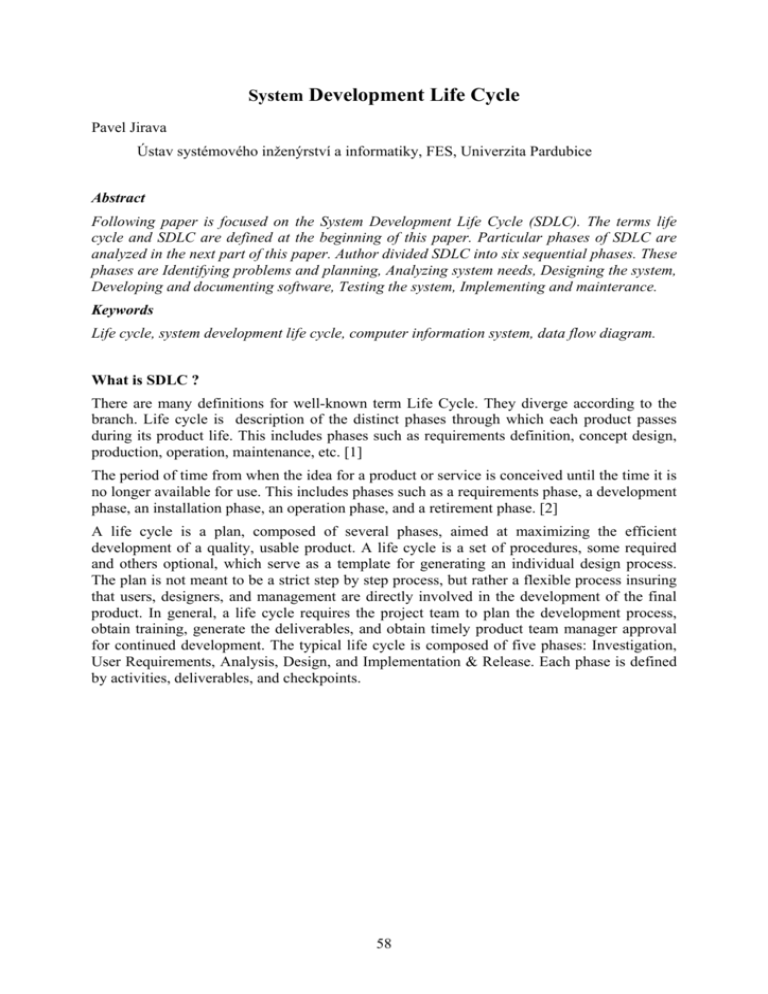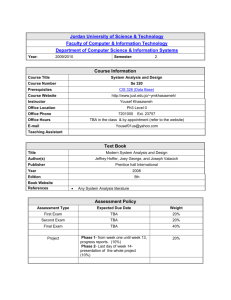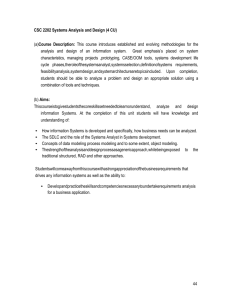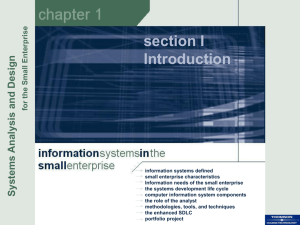
System Development Life Cycle
Pavel Jirava
Ústav systémového inženýrství a informatiky, FES, Univerzita Pardubice
Abstract
Following paper is focused on the System Development Life Cycle (SDLC). The terms life
cycle and SDLC are defined at the beginning of this paper. Particular phases of SDLC are
analyzed in the next part of this paper. Author divided SDLC into six sequential phases. These
phases are Identifying problems and planning, Analyzing system needs, Designing the system,
Developing and documenting software, Testing the system, Implementing and mainterance.
Keywords
Life cycle, system development life cycle, computer information system, data flow diagram.
What is SDLC ?
There are many definitions for well-known term Life Cycle. They diverge according to the
branch. Life cycle is description of the distinct phases through which each product passes
during its product life. This includes phases such as requirements definition, concept design,
production, operation, maintenance, etc. [1]
The period of time from when the idea for a product or service is conceived until the time it is
no longer available for use. This includes phases such as a requirements phase, a development
phase, an installation phase, an operation phase, and a retirement phase. [2]
A life cycle is a plan, composed of several phases, aimed at maximizing the efficient
development of a quality, usable product. A life cycle is a set of procedures, some required
and others optional, which serve as a template for generating an individual design process.
The plan is not meant to be a strict step by step process, but rather a flexible process insuring
that users, designers, and management are directly involved in the development of the final
product. In general, a life cycle requires the project team to plan the development process,
obtain training, generate the deliverables, and obtain timely product team manager approval
for continued development. The typical life cycle is composed of five phases: Investigation,
User Requirements, Analysis, Design, and Implementation & Release. Each phase is defined
by activities, deliverables, and checkpoints.
58
Identifying problems, planning
Analyzing system needs
Designing the system
Developing and documneting SW
Testing the system
Implementing and maintenance
Figure 1 – SDLC
A little different meaning has term System development life cycle. It is usually seen as an
organized, structured, methodology for developing, implementing, and installing a new or
revised Computer Information System (CIS). Standard phases include investigation, analysis
and general design, detailed design and implementation, installation, and review. The SDLC
is a phased approach to analysis and design that holds that systems are best developed
through the use of a specific cycle of analyst and user acivities. Specialist disagree on exactly
how many phases there are in SDLC. Every system development organization or textbook
author uses slightly different life cycle model, with anwhere from three to almost twenty
phases [3] [4]. I came out from works of this authors in the course of creating my model of
SDLC. I employed my own skills with implementing new information systems too. I have
divided live cycle into six stages which can be found in Figure1. This stages are not isolated
– they together create entity. Some stages can occur simultaneously or may be repeated.
So what SDLC is? It is the process we would follow to build a information system. Basically
it is the process companies go through to develop new information system. System
development methodologies provide a framework for sucessful development of IS. Many
information systems consulting companies develop their own methodologies. They use these
proprietary methodologies as a means of differentiating themselves from the competition.
Identifying problems, planning
This is the first and very important phase of system development live cycle. This phase is
critical to the success of the project .
Specialist identifies the need for a new or enhanced system. Information needs of the
organization are examined and projects to meet these needs are proactively identified.The
organizations IS needs may result from requests to deal with problems in current procedures,
from the desire to perform additional tasks, or from realization that information technology
could be used to capitalize on an existing opportunity. These needs can then be prioritized and
translated into a plan for the IS department, including a schedule for developing new major
systems. In smaller organizations determination of which systems to develop may be affected
by ad hoc user requests submitted as the need for new or enhanced systems arises, as well as
from formalized information planning system. Two additional major activities are also
59
performed during the planning phase, the formal, yet still preliminary , investigation of the
system problem or opportunity at hand and the presentation of reasons why the system should
or should be not developed by the organization.
Analyzing system needs
In this phase special tools help the analyst make requirement determinations. One such tool is
the use of data flow diagrams. With DFD (see Figure 2) are input, processes and output of the
business functions convert into structured graphical form. During analysis the analyst studies
the organization´s current procedures and the information systems used to perform
organizational tasks. They prepares materials that sumarizes what has been found , provides
cost and benefits analyses of alternatives and makse recommendations on what should be
done. Once the recommendation is accepted the analyst can begin to make plans to acquire
any hardware and system software necessary to build or operate the system as proposed.
Data flow
Process
External Entity
Data store
Figure 2 - Data flow diagram symbols
Designing the system
In this phase of SDLC analyst uses the information collected earlier to accomplish the logical
design of the information system. The analyst designs accurate data entry procedures so that
data going into the information system are correct. In addition the analyst provides for
effective input to the information system by using techniques of good form and screen design.
Part of the logical design of the information system is devising the user interface. The
interface connects the user with the system and is thus extremly important. Examples of user
interface include keyboard or onscreen menus.
This phase also includes designing files or databases that will store much of the data needed
by decision makers in the organization. A well organized database is the basis for all
information systems. In this phase analyst also works with users to design output that meets
their information needs.
They must design also controls and and backup procedures to protect the system and the data
and to produce program specification packets for programmers. Each packet should contain
input and output layouts , file specifications and processing details – it may also include data
flow diagrams, system flowcharts.
Developing and documenting software
In this phase the analyst works with programmers to develop any original software that is
needed. Some of the structured techniques for designing and documenting software include
structure charts or Nassi Scheiderman charts.
60
The system analyst uses one or more of these devices to communicate to the programmer
what needs to be programmed.
During this phase the analyst also works with users to develop effective documetation for
software including procedure manuals, online help, „Frequently asked questions“, Read me
files. Documentation tells users how to use software and what to do if software problems
occurs. Programmers have a key role in this phase because they design, code and remove
syntactical errors from computer programs. If the program is to run in a mainframe
environment job control language must be created.
Testing the system
So the system is build but is not ready for implementation. Before a company can run the
system, it must be tested. It is much less costly to catch problems before the system is signed
over the users . Some of the testing is completed by programmers alone, some of it by system
analyst in conjunction with programmers. A series of tests to pinpoint problems is run first
with sample data and eventually with actual data from the current system.
Implementing and mainterance
This is the last phase of system development. The analyst helps to implement the information
system. This phase involves training the users to handle the system. Some training is done by
vendors, but oversight of training is the resposibility of the system analyst. In addition the
analyst needs to plan for a smooth conversion from the old system to the new one. This
process includes converting files from old formats to new ones or building a database,
installing equipment and bringing the new system into production.
This phase of SDLC requires empoyees to use the new, unfamiliar system. This should be
critical for final sucess.
A number of implementation approaches exists:
Direct cutover implementation is when company quickly changes an old system for a new
one. Usually a direct cutover implementation takes place over a weekend when empoyees are
out of office. It can be very risky. It is risky in that, even after all of the testing , the new
system may not function correctly.
In parallel conversion approach a company installs a new system alongside its old system.
This approach allows the organization and its emloyees to move to the new system gradually.
The risk is that empoees will continue to use old system.
Pilot testing is next approach. In pilot testing a company installs a new system at only one
location or in one department. Once the system has passed testing in this department is
installed in all departments.
By some estimates the mainterance accounts much as 80 percent [5] of the total costs of an
information system. These estimates make sense when we consider that it might takes only a
few month to a year to develop a new information system, but that system might be placed for
decades. Mainterance includes , but is not limited to , correcting errors, backing up data or
supporting end users. Some of the errors go undetected in the testing phase. It is when
emploees start using a new system that these errors come to the surface. Correcting these
errors is one of the most important part of system mainterance.
61
Conclusion
System analysis and design is a systematic approach to identifying problems, opportunities
and objectives to analyze the information flows in organizations, and to designing
computerized information systems to solve the problems. The framework for this systematic
approach is providet in what is called the system development live cycle (SDLC). This cycle
can be divided into 3 – 20 stages [3]. I divide SDLC into six sequential stages. The six stages
are Identifying problems and planning, Analyzing system needs, Designing the system,
Developing and documenting software, Testing the system, Implementing and mainterance.
Literatura:
1) CERN Engineering data management service [online]. Ženeva. Dostupné z WWW:
<cedar.web.cern.ch/CEDAR/glossary.html>
2) Process Advatnage Technology [online]. San Francisco. Dostupné z WWW:
<www.patech.com/glossary.htm>
3) Hoffer, J.: Modern system analysis and design, fourth edition, Pearson Prentice Hall, New Jersey, 2002,
4) Saldarini, R.: Analysis and design of business information systems,Macmillan PC, New York, 1990
ISBN 0-02-946403-x
5) Vlasák, R.; Bulíčková,S.: Základy projektování informačích systémů, Praha, Univerzita Karlova, 2003,
ISBN 80-246-0727-1
Kontaktní adresa:
Ing. Pavel Jirava
Univerzita Pardubice
Fakulta ekonomicko správní
Ústav systémového inženýrství a informatiky
Studentská 84, 532 10 Pardubice
e-mail: pavel.jirava@upce.cz
tel: 466036001
Recenzovala: Ing. Hana Kopáčková, Ph.D., ÚSII, FES UPa
62










